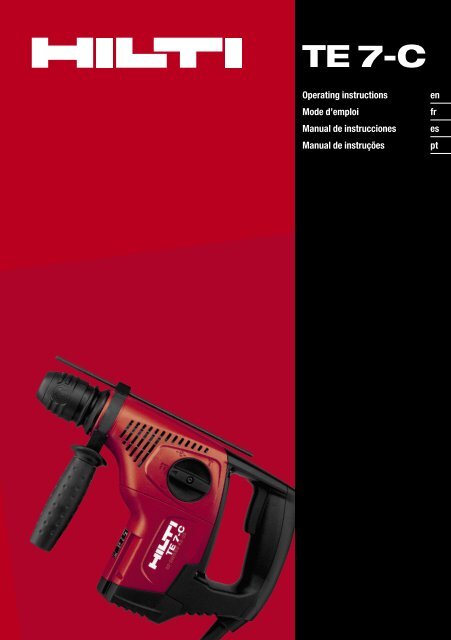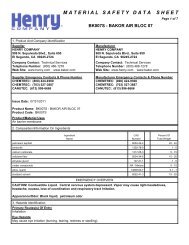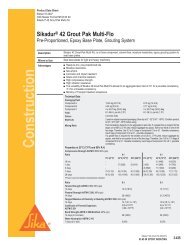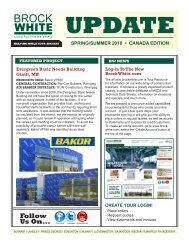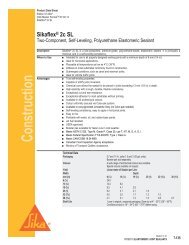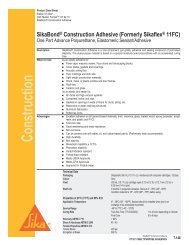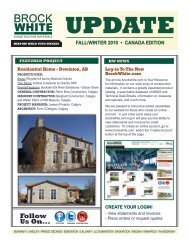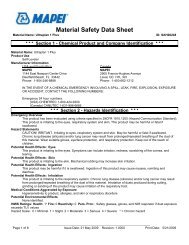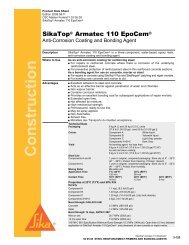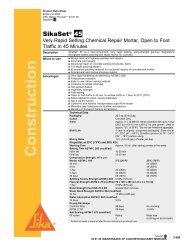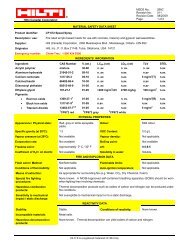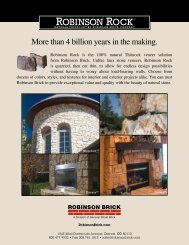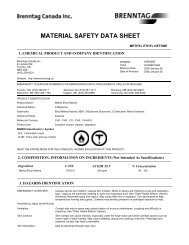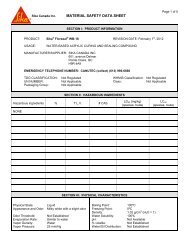Operations Manual - TE 7-C Rotary Hammer Drill - Home Depot
Operations Manual - TE 7-C Rotary Hammer Drill - Home Depot
Operations Manual - TE 7-C Rotary Hammer Drill - Home Depot
You also want an ePaper? Increase the reach of your titles
YUMPU automatically turns print PDFs into web optimized ePapers that Google loves.
<strong>TE</strong> 7-C<br />
Operating instructions<br />
Mode d’emploi<br />
<strong>Manual</strong> de instrucciones<br />
<strong>Manual</strong> de instruções<br />
en<br />
fr<br />
es<br />
pt
1<br />
This Product is Listed<br />
Ce produit est homologué<br />
Producto homologado por<br />
Este produto está registrado
2<br />
3<br />
4 5<br />
6 7<br />
8 9
ORIGINAL OPERATING INSTRUCTIONS<br />
<strong>TE</strong> 7‐C rotary hammer<br />
It is essential that the operating instructions<br />
are read before the power tool is operated<br />
for the first time.<br />
Always keep these operating instructions<br />
together with the power tool.<br />
Ensure that the operating instructions are<br />
with the power tool when it is given to<br />
other persons.<br />
Contents<br />
Page<br />
1. General information 1<br />
2. Description 2<br />
3. Insert tools, accessories 4<br />
4. Technical data 4<br />
5. Safety instructions 5<br />
6. Before use 8<br />
7. Operation 8<br />
8. Care and maintenance 10<br />
9. Troubleshooting 11<br />
10. Disposal 12<br />
11. Manufacturer’s warranty - tools 12<br />
1 These numbers refer to the corresponding illustrations.<br />
The illustrations can be found on the fold-out<br />
cover pages. Keep these pages open while studying<br />
the operating instructions.<br />
In these operating instructions, the designation “the<br />
power tool” always refers to the <strong>TE</strong> 7-C rotary hammer.<br />
Operating controls and parts 1<br />
@ Chucks<br />
; Function selector switch<br />
= Control switch<br />
% Forward / reverse switch<br />
& Side handle with depth gauge<br />
( Interface for <strong>TE</strong> DRS‐M dust removal module<br />
) Supply cord<br />
en<br />
1. General information<br />
1.1 Safety notices and their meaning<br />
DANGER<br />
Draws attention to imminent danger that could lead<br />
to serious bodily injury or fatality.<br />
WARNING<br />
Draws attention to a potentially dangerous situation<br />
that could lead to serious personal injury or fatality.<br />
NO<strong>TE</strong><br />
Draws attention to an instruction or other useful<br />
information.<br />
1.2 Explanation of the pictograms and other<br />
information<br />
Warning signs<br />
CAUTION<br />
Draws attention to a potentially dangerous situation<br />
that could lead to slight personal injury or damage to<br />
the equipment or other property.<br />
General<br />
warning<br />
Warning:<br />
electricity<br />
1
Obligation signs<br />
en<br />
Wear eye<br />
protection<br />
Wear a hard<br />
hat<br />
Wear ear<br />
protection<br />
Wear<br />
protective<br />
gloves<br />
Alternating<br />
current<br />
Hertz<br />
Rated speed<br />
under no load<br />
Revolutions<br />
per minute<br />
Diameter<br />
Double<br />
insulated<br />
Reverse<br />
rotation<br />
Forward<br />
rotation<br />
Wear<br />
breathing<br />
protection<br />
Symbols<br />
Location of identification data on the power tool<br />
The type designation can be found on the type identification<br />
plate and the serial number on the side of<br />
the motor housing. Make a note of this data in your<br />
operating instructions and always refer to it when<br />
making an enquiry to your Hilti representative or<br />
service department.<br />
Read the<br />
operating<br />
instructions<br />
before use<br />
Return waste<br />
material for<br />
recycling.<br />
<strong>Drill</strong>ing<br />
without<br />
hammering<br />
<strong>Hammer</strong><br />
drilling<br />
Type:<br />
Serial no.:<br />
Chiseling<br />
Chisel position<br />
adjustment<br />
Volts<br />
Amps<br />
2. Description<br />
2.1 Use of the product as directed<br />
The power tool is an electrically-powered rotary hammer with pneumatic hammering mechanism.<br />
The power tools are designed for drilling in concrete, masonry, gypsum board (drywall), wood, plastic and<br />
metal. The power tool can also be used for light chiseling work on masonry and surface finishing on concrete.<br />
Working on materials hazardous to the health (e.g. asbestos) is not permissible.<br />
The power tool is designed for professional use. The power tool may be operated, serviced and repaired<br />
only by authorized, trained personnel. This personnel must be informed of any special hazards that may be<br />
encountered.<br />
The power tool and its ancillary equipment may present hazards when used incorrectly by untrained personnel<br />
or when used not as directed.<br />
The working environment may be as follows: construction site, workshop, renovation, conversion or new<br />
construction. The power tool may be operated only when connected to a power supply providing a voltage and<br />
frequency in compliance with the information given on its type identification plate.<br />
Changes or modifications to the power tool are not permissible.<br />
To avoid the risk of injury, use only genuine Hilti accessories and insert tools.<br />
Observe the information printed in the operating instructions concerning operation, care and maintenance.<br />
2
2.2 Chucks<br />
<strong>TE</strong>‐C CLICK chuck<br />
2.3 Switches<br />
Speed control switch for smooth starting.<br />
Function selector switch:<br />
<strong>Drill</strong>ing without hammering<br />
<strong>Hammer</strong> drilling<br />
Chisel adjustment (18 positions)<br />
Chiseling<br />
en<br />
2.4 Grips<br />
Vibration-absorbing, pivotable side handle with depth gauge<br />
Vibration-absorbing grip<br />
2.5 Protective feature<br />
Mechanical slip clutch<br />
2.6 Lubrication<br />
Oil lubrication<br />
2.7 Items supplied as standard<br />
1 Power tool<br />
1 <strong>TE</strong>‐C CLICK chuck<br />
1 Side handle with depth gauge<br />
1 Operating instructions<br />
1 Hilti toolbox<br />
1 Cleaning cloth<br />
1 Grease<br />
2.8 Using extension cords<br />
Use only extension cords of a type approved for the application and with conductors of adequate cross section.<br />
The power tool may otherwise loose performance and the extension cord may overheat. Check the extension<br />
cord for damage at regular intervals. Replace damaged extension cords.<br />
Recommended minimum conductor cross section and max. cable lengths<br />
Conductor cross section<br />
1.5 mm² 2.5 mm² 3.5 mm² 14 AWG 12 AWG<br />
Mains voltage 100V<br />
50 m<br />
Mains voltage 110- 30 m 50 m 100 ft 150 ft<br />
120 V<br />
Mains voltage 220-<br />
240 V<br />
75 m 100 m<br />
Do not use extension cords with 1.25 mm² or 16 AWG conductor cross sections.<br />
3
2.9 Using extension cords outdoors<br />
When working outdoors, use only extension cords that are approved and correspondingly marked for this<br />
application.<br />
en<br />
2.10 Using a generator or transformer<br />
This power tool may be powered by a generator or transformer which fulfills the following conditions: The unit<br />
must provide a power output in watts of at least twice the value printed on the rating plate on the power tool.<br />
The operating voltage must remain within +5% and -15% of the rated voltage at all times, frequency must be in<br />
the 50 – 60 Hz range and never above 65 Hz, and the unit must be equipped with automatic voltage regulation<br />
and starting boost.<br />
Never operate other power tools or appliances from the generator or transformer at the same time. Switching<br />
other power tools or appliances on and off may cause undervoltage and / or overvoltage peaks, resulting in<br />
damage to the power tool.<br />
3. Insert tools, accessories<br />
Designation<br />
Chucks<br />
<strong>Hammer</strong> drill bits<br />
Forming and installation drill bits<br />
Lightweight percussion core bits<br />
Multipurpose hole saws<br />
Pointed chisel<br />
Flat chisel<br />
Shaped chisels<br />
Anchor-setting tools<br />
Quick-release chuck for wood and metal drill bits<br />
Key-type chuck<br />
Wood drill bits<br />
Metal drill bits<br />
Metal drill bits / stepped drill bits<br />
Designation<br />
Dust module<br />
Angular chuck<br />
Description<br />
<strong>TE</strong>‐C CLICK<br />
Ø 5…28 mm<br />
Ø 5…20 mm<br />
Ø 25…68 mm<br />
Ø 25…82 mm, hexagonal<br />
C-type connection end<br />
C-type connection end<br />
C-type connection end<br />
C-type connection end<br />
For smooth or hex. shank<br />
With smooth or hex. shank<br />
Ø 3…20 mm<br />
Ø Max. 13 mm<br />
Ø 5…22 mm<br />
Description<br />
<strong>TE</strong> DRS-M<br />
C-type connection end<br />
4. Technical data<br />
Right of technical changes reserved.<br />
NO<strong>TE</strong><br />
The power tool is available in various voltage ratings. Please refer to the power tool’s type identification plate<br />
for details of its rated voltage and rated input power.<br />
4
Power tool <strong>TE</strong> 7‐C<br />
Rated voltage<br />
120 V<br />
Rated current input<br />
6.3 A<br />
Mains frequency<br />
60 Hz<br />
Weight of the tool, including side handle<br />
3.5 kg<br />
Dimensions (L x W x H)<br />
341 mm x 86 mm x 217 mm<br />
<strong>Drill</strong>ing speed without hammering<br />
0…900/min<br />
<strong>Hammer</strong> drilling speed<br />
740/min<br />
Single impact energy<br />
2.6 J<br />
Other information about the power tool<br />
Chuck<br />
<strong>TE</strong>‐C Click<br />
<strong>Drill</strong>ing performance in medium-hard concrete Ø 16 mm: 56 cm³/min<br />
Protection class<br />
Protection class I (grounded) or protection class II<br />
(double insulated). See type identification plate.<br />
en<br />
5. Safety instructions<br />
NO<strong>TE</strong><br />
contain all general safety rules for power tools which,<br />
in accordance with the applicable standards, require<br />
to be listed in the operating instructions. Accordingly,<br />
some of the rules listed may not be relevant to this<br />
tool.<br />
5.1 General Power Tool Safety Warnings<br />
a)<br />
WARNING<br />
Read all safety warnings and all instructions.<br />
Failure to follow the warnings and instructions<br />
may result in electric shock, fire and/or serious<br />
injury. Save all warnings and instructions for<br />
future reference. The term “power tool” in the<br />
warnings refers to your mains-operated (corded)<br />
power tool or battery-operated (cordless) power<br />
tool.<br />
5.1.1 Work area safety<br />
a) Keep work area clean and well lit. Cluttered or<br />
dark areas invite accidents.<br />
b) Do not operate power tools in explosive atmospheres,<br />
such as in the presence of flammable<br />
liquids, gases or dust. Power tools create sparks<br />
which may ignite the dust or fumes.<br />
c) Keep children and bystanders away while operating<br />
a power tool. Distractions can cause you to<br />
lose control.<br />
5.1.2 Electrical safety<br />
a) Power tool plugs must match the outlet. Never<br />
modify the plug in any way. Do not use any<br />
adapter plugs with earthed (grounded) power<br />
tools. Unmodified plugs and matching outlets<br />
will reduce risk of electric shock.<br />
b) Avoid body contact with earthed or grounded<br />
surfaces, such as pipes, radiators, ranges and<br />
refrigerators. There is an increased risk of electric<br />
shock if your body is earthed or grounded.<br />
c) Do not expose power tools to rain or wet conditions.<br />
Water entering a power tool will increase<br />
the risk of electric shock.<br />
d) Do not abuse the cord. Never use the cord for<br />
carrying, pulling or unplugging the power tool.<br />
Keep cord away from heat, oil, sharp edges<br />
or moving parts. Damaged or entangled cords<br />
increase the risk of electric shock.<br />
e) When operating a power tool outdoors, use an<br />
extension cord suitable for outdoor use. Use of<br />
a cord suitable for outdoor use reduces the risk<br />
of electric shock.<br />
f) If operating a power tool in a damp location<br />
is unavoidable, use a residual current device<br />
(RCD) protected supply. Use of an RCD reduces<br />
the risk of electric shock.<br />
5
en<br />
5.1.3 Personal safety<br />
a) Stay alert, watch what you are doing and use<br />
common sense when operating a power tool. Do<br />
not use a power tool while you are tired or under<br />
the influence of drugs, alcohol or medication.<br />
A moment of inattention while operating power<br />
tools may result in serious personal injury.<br />
b) Use personal protective equipment. Always<br />
wear eye protection. Protective equipment<br />
such as dust mask, non-skid safety shoes, hard<br />
hat, or hearing protection used for appropriate<br />
conditions will reduce personal injuries.<br />
c) Prevent unintentional starting. Ensure the<br />
switch is in the off‐position before connecting<br />
to power source and/or battery pack, picking up<br />
or carrying the tool. Carrying power tools with<br />
your finger on the switch or energising power<br />
tools that have the switch on invites accidents.<br />
d) Remove any adjusting key or wrench before<br />
turning the power tool on. A wrench or a key left<br />
attached to a rotating part of the power tool may<br />
result in personal injury.<br />
e) Do not overreach. Keep proper footing and balance<br />
at all times. This enables better control of<br />
the power tool in unexpected situations.<br />
f) Dress properly. Do not wear loose clothing or<br />
jewellery. Keep your hair, clothing and gloves<br />
away from moving parts. Loose clothes, jewellery<br />
or long hair can be caught in moving parts.<br />
g) If devices are provided for the connection of<br />
dust extraction and collection facilities, ensure<br />
these are connected and properly used. Use of<br />
dust collection can reduce dust-related hazards.<br />
5.1.4 Power tool use and care<br />
a) Do not force the power tool. Use the correct<br />
power tool for your application. The correct<br />
power tool will do the job better and safer at the<br />
rate for which it was designed.<br />
b) Do not use the power tool if the switch does not<br />
turn it on and off. Any power tool that cannot be<br />
controlled with the switch is dangerous and must<br />
be repaired.<br />
c) Disconnect the plug from the power source<br />
and/or the battery pack from the power tool<br />
before making any adjustments, changing accessories,<br />
or storing power tools. Such preventive<br />
safety measures reduce the risk of starting the<br />
power tool accidentally.<br />
d) Store idle power tools out of the reach of children<br />
and do not allow persons unfamiliar with<br />
the power tool or these instructions to operate<br />
the power tool. Power tools are dangerous in the<br />
hands of untrained users.<br />
e) Maintain power tools. Check for misalignment<br />
or binding of moving parts, breakage of parts<br />
and any other condition that may affect the<br />
power tool’s operation. If damaged, have the<br />
power tool repaired before use. Many accidents<br />
are caused by poorly maintained power tools.<br />
f) Keep cutting tools sharp and clean. Properly<br />
maintained cutting tools with sharp cutting edges<br />
are less likely to bind and are easier to control.<br />
g) Use the power tool, accessories and tool bits<br />
etc. in accordance with these instructions, taking<br />
into account the working conditions and the<br />
work to be performed. Use of the power tool for<br />
operations different from those intended could<br />
result in a hazardous situation.<br />
5.1.5 Service<br />
a) Have your power tool serviced by a qualified<br />
repair person using only identical replacement<br />
parts. This will ensure that the safety of the power<br />
tool is maintained.<br />
5.2 <strong>Hammer</strong> safety warnings<br />
a) Wear ear protectors. Exposure to noise can cause<br />
hearing loss.<br />
b) Use auxiliary handle(s), if supplied with the<br />
tool. Loss of control can cause personal injury.<br />
c) Hold power tool by insulated gripping surfaces,<br />
when performing an operation where the cutting<br />
accessory may contact hidden wiring or its own<br />
cord. Cutting accessory contacting a "live" wire<br />
may make exposed metal parts of the power tool<br />
"live" and could give the operator an electric shock.<br />
5.3 Additional safety precautions<br />
5.3.1 Personal safety<br />
a) Always hold the power tool securely with both<br />
hands on the grips provided. Keep the grips dry,<br />
clean and free from oil and grease.<br />
b) Breathing protection must be worn if the power<br />
tool is used without a dust removal system for<br />
work that creates dust.<br />
c) Improve the blood circulation in your fingers by<br />
relaxing your hands and exercising your fingers<br />
during breaks between working.<br />
d) Avoid touching rotating parts. Switch the power<br />
tool on only after bringing it into position at the<br />
6
workpiece. Touching rotating parts, especially<br />
rotating insert tools, may lead to injury.<br />
e) Always lead the supply cord and extension cord<br />
away from the power tool to the rear while<br />
working. This helps to avoid tripping over the<br />
cord while working.<br />
f) Children must be instructed not to play with the<br />
power tool.<br />
g) The power tool is not intended for use by children,<br />
by debilitated persons or those who have<br />
received no instruction or training.<br />
h) WARNING: Some dust created by grinding,<br />
sanding, cutting and drilling contains chemicals<br />
known to cause cancer, birth defects,<br />
infertility or other reproductive harm; or serious<br />
and permanent respiratory or other injury.<br />
Some examples of these chemicals are: lead from<br />
lead-based paints, crystalline silica from bricks,<br />
concrete and other masonry products and natural<br />
stone, arsenic and chromium from chemicallytreated<br />
lumber. Your risk from these exposures<br />
varies, depending on how often you do this type<br />
of work. To reduce exposure to these chemicals,<br />
the operator and bystanders should work in a<br />
well-ventilated area, work with approved safety<br />
equipment, such as respiratory protection appropriate<br />
for the type of dust generated, and<br />
designed to filter out microscopic particles and<br />
direct dust away from the face and body. Avoid<br />
prolonged contact with dust. Wear protective<br />
clothing and wash exposed areas with soap and<br />
water. Allowing dust to get into your mouth,<br />
eyes, or to remain on your skin may promote<br />
absorption of harmful chemicals.<br />
5.3.2 Power tool use and care<br />
a) Secure the workpiece. Use clamps or a vice<br />
to secure the workpiece. The workpiece is thus<br />
held more securely than by hand and both hands<br />
remain free to operate the power tool.<br />
b) Check that the insert tools used are compatible<br />
with the chuck system and that they are secured<br />
in the chuck correctly.<br />
c) Switch the power tool off and unplug the supply<br />
cord in the event of a power failure or interruption<br />
in the electric supply. This will prevent<br />
accidental restarting when the electric power returns.<br />
5.3.3 Electrical safety<br />
a) Before beginning work, check the working area<br />
(e.g. using a metal detector) to ensure that<br />
no concealed electric cables or gas and water<br />
pipes are present. External metal parts of the<br />
power tool may become live, for example, when<br />
an electric cable is damaged accidentally. This<br />
presents a serious risk of electric shock.<br />
b) Check the power tool’s supply cord at regular<br />
intervals and have it replaced by a qualified<br />
specialist if found to be damaged. If the power<br />
tool’s supply cord is damaged it must be replaced<br />
with a specially-prepared supply cord<br />
available from Hilti Customer Service. Check<br />
extension cords at regular intervals and replace<br />
them if found to be damaged. Do not touch the<br />
supply cord or extension cord if it is damaged<br />
while working. Disconnect the supply cord plug<br />
from the power outlet. Damaged supply cords or<br />
extension cords present a risk of electric shock.<br />
c) Dirty or dusty power tools which have been<br />
used frequently for work on conductive materials<br />
should be checked at regular intervals at<br />
a Hilti Service Center. Under unfavorable circumstances,<br />
dampness or dust adhering to the<br />
surface of the power tool, especially dust from<br />
conductive materials, may present a risk of electric<br />
shock.<br />
d) When working outdoors with an electric tool<br />
check to ensure that the tool is connected to the<br />
electric supply by way of a ground fault circuit<br />
interrupter (GFCI) with a rating of max. 30 mA<br />
(tripping current). Use of a ground fault circuit<br />
interrupter reduces the risk of electric shock.<br />
e) Use of a ground fault circuit interrupter (GFCI)<br />
with a maximum tripping current of 30 mA is<br />
recommended.<br />
5.3.4 Work area safety<br />
a) Ensure that the workplace is well lit.<br />
b) Ensure that the workplace is well ventilated.<br />
Exposure to dust at a poorly ventilated workplace<br />
may result in damage to the health.<br />
en<br />
7
c) If the work involves breaking right through, take<br />
the appropriate safety measures at the opposite<br />
side. Parts breaking away could fall out and / or<br />
fall down and injure other persons.<br />
hat, ear protection, protective gloves and breathing<br />
protection while the machine is in use.<br />
en<br />
5.3.5 Personal protective equipment<br />
The user and any other persons in the vicinity must<br />
wear ANSI Z87.1-approved eye protection, a hard<br />
6. Before use<br />
6.1 Fitting the side handle 2<br />
CAUTION<br />
Remove the depth gauge from the side handle in<br />
order to avoid injury.<br />
1. Disconnect the supply cord plug from the power<br />
outlet.<br />
2. Release the side handle clamping band by turning<br />
the handle counterclockwise.<br />
3. Slide the side handle clamping band over the<br />
chuck and onto the cylindrical section at the<br />
front end of the power tool.<br />
4. Pivot the side handle into the desired position.<br />
5. CAUTION Check that the clamping band is engaged<br />
in the groove provided on the power<br />
tool.<br />
Secure the side handle by turning the grip clockwise.<br />
6.2 Use of extension cords and generators or<br />
transformers<br />
Please refer to the “Description” section.<br />
7. Operation<br />
7.1 Preparing for use<br />
CAUTION<br />
In the event of the drill bit sticking, the power tool<br />
will pivot about its own axis. Always use the power<br />
tool with the side handle fitted and hold it securely<br />
with both hands so that the resulting opposing force<br />
causes the slip clutch to release in the event of the<br />
drill bit sticking. Use clamps or a vice to hold the<br />
workpiece securely.<br />
7.1.1 Adjusting the depth gauge 3<br />
1. Release the side handle clamping band by turning<br />
the handle counterclockwise.<br />
2. Pivot the side handle into the desired position.<br />
3. Adjust the depth gauge to the desired drilling<br />
depth.<br />
4. Tighten the side handle securely by turning the<br />
grip section. This also clamps the depth gauge<br />
in position.<br />
8
7.1.2 Fitting the insert tool 4<br />
CAUTION<br />
Wear protective gloves when changing the insert tool.<br />
1. Disconnect the supply cord plug from the power<br />
outlet.<br />
2. Check that the connection end of the insert tool<br />
is clean and lightly greased. Clean it and grease<br />
it if necessary.<br />
3. Check that the sealing lip of the dust shield<br />
is clean and in good condition. Clean the dust<br />
shield if necessary or replace it if the sealing lip<br />
is found to be damaged (please refer to the “Care<br />
and maintenance” section).<br />
4. Push the insert tool into the chuck and rotate it<br />
while applying slight pressure until it engages in<br />
the guide grooves.<br />
5. Push the insert tool further into the chuck until it<br />
is heard to engage.<br />
6. Check that the insert tool has engaged correctly<br />
by pulling it.<br />
7.1.3 Removing the insert tool 5<br />
CAUTION<br />
Wear protective gloves when changing insert tools as<br />
the insert tool will get hot during use.<br />
1. Disconnect the supply cord plug from the power<br />
outlet.<br />
2. Open the chuck by pulling back the chuck release<br />
sleeve.<br />
3. Pull the insert tool out of the chuck.<br />
7.1.4 Removing the chuck 6<br />
CAUTION<br />
Remove the depth gauge from the side handle and<br />
the insert tool from the chuck in order to avoid injury.<br />
NO<strong>TE</strong><br />
Set the selector switch to the “Chiseling” position<br />
before removing the chuck.<br />
1. Disconnect the supply cord plug from the power<br />
outlet.<br />
2. Pull the chuck sleeve forward and hold it securely.<br />
3. Remove the chuck by pulling it away from the<br />
power tool.<br />
7.1.5 Fitting the chuck 7<br />
CAUTION<br />
Remove the depth gauge from the side handle and<br />
the insert tool from the chuck in order to avoid injury.<br />
NO<strong>TE</strong><br />
Set the selector switch to the “Chiseling” position<br />
before removing the chuck.<br />
1. Disconnect the supply cord plug from the power<br />
outlet.<br />
2. Grip the chuck sleeve, pull it forward and hold it<br />
securely in this position.<br />
3. Slide the chuck onto the guide tube from the<br />
front and then release the sleeve.<br />
4. Rotate the chuck until it is heard to engage.<br />
7.2 Operation<br />
CAUTION<br />
Working on the material may cause it to splinter.<br />
Wear eye protection and protective gloves. Wear<br />
breathing protection if no dust removal system is<br />
used. Splintering material presents a risk of injury to<br />
the eyes and body.<br />
CAUTION<br />
The work generates noise. Wear ear protectors.<br />
Exposure to noise can cause hearing loss.<br />
7.2.1 Working at low temperatures<br />
NO<strong>TE</strong><br />
The hammering mechanism works only when the<br />
power tool has reached a minimum operating temperature.<br />
Bring the drill bit briefly into contact with the base<br />
material while allowing the power tool to run under<br />
no load until the minimum operating temperature is<br />
reached. If necessary, repeat this procedure until the<br />
hammering mechanism begins to operate.<br />
en<br />
9
en<br />
7.2.2 <strong>Drill</strong>ing without hammering 8<br />
1. Turn the function selector switch until it engages<br />
in the “<strong>Drill</strong>ing without hammering” position. Do<br />
not operate the function selector switch while<br />
the motor is running.<br />
2. Bring the side handle into the desired position<br />
and check that it is fitted correctly and secured.<br />
3. Plug the supply cord into the power outlet.<br />
4. Position the power tool and drill bit at the point<br />
where the hole is to be drilled.<br />
5. Press the control switch slowly (drill at a low<br />
speed until the drill bit centers itself in the hole).<br />
6. Press the control switch fully to continue drilling<br />
with full power.<br />
7. Adjust the pressure applied to the power tool<br />
according to the material you are working on.<br />
This will ensure the optimum rate of drilling<br />
progress.<br />
7.2.3 <strong>Hammer</strong> drilling 8<br />
1. Turn the function selector switch until it engages<br />
in the “<strong>Hammer</strong> drilling” position. Do not operate<br />
the function selector switch while the motor is<br />
running.<br />
2. Bring the side handle into the desired position<br />
and check that it is fitted correctly and secured.<br />
3. Plug the supply cord into the power outlet.<br />
4. Position the power tool and drill bit at the point<br />
where the hole is to be drilled.<br />
5. Press the control switch slowly (drill at a low<br />
speed until the drill bit centers itself in the hole).<br />
6. Press the control switch fully to continue drilling<br />
with full power.<br />
7. Do not apply excessive pressure. This will not<br />
increase the power tool’s hammering performance.<br />
Lower pressure extends the life of the<br />
insert tool.<br />
8. Reduce drilling speed shortly before breaking<br />
through in order to avoid spalling.<br />
7.2.4 Chiseling<br />
NO<strong>TE</strong><br />
The chisel can be adjusted to 18 different positions<br />
(in 20° increments). This ensures that flat chisels and<br />
shaped chisels can always be set to the optimum<br />
working position.<br />
7.2.4.1 Chisel position adjustment<br />
CAUTION<br />
Do not work operate the power tool when the selector<br />
switch is set to “Chisel adjustment”.<br />
1. Turn the function selector switch until it engages<br />
in the “Chisel adjustment” position. Do not operate<br />
the function selector switch while the motor<br />
is running.<br />
2. Bring the side handle into the desired position<br />
and check that it is fitted correctly and secured.<br />
3. Rotate the chisel to the desired position.<br />
7.2.4.2 Locking the chisel<br />
Turn the function selector switch until it engages in<br />
the “Chiseling” position. Do not operate the function<br />
selector switch while the motor is running.<br />
7.2.4.3 Chiseling 8<br />
1. Plug the supply cord into the power outlet.<br />
NO<strong>TE</strong> Do not operate the function selector switch<br />
while the motor is running.<br />
2. Position the tip of the chisel at the point where<br />
chiseling is to begin.<br />
3. Press the control switch.<br />
7.2.5 Forward / reverse 9<br />
CAUTION<br />
Do not operate the forward / reverse switch while the<br />
motor is running.<br />
Move the forward/reverse switch to the “Forward” or<br />
“Reverse” position.<br />
8. Care and maintenance<br />
CAUTION<br />
Disconnect the mains plug from the power outlet.<br />
8.1 Care of insert tools<br />
Clean off dirt and dust deposits adhering to the insert<br />
tools and protect them from corrosion by wiping the<br />
insert tools from time to time with an oil-soaked rag.<br />
8.2 Care of the power tool<br />
CAUTION<br />
Keep the power tool, especially its grip surfaces,<br />
clean and free from oil and grease. Do not use<br />
cleaning agents which contain silicone.<br />
10
The outer casing of the power tool is made from<br />
impact-resistant plastic. Sections of the grip are made<br />
from a synthetic rubber material.<br />
Never operate the power tool when the ventilation<br />
slots are blocked. Clean the ventilation slots carefully<br />
using a dry brush. Do not permit foreign objects to<br />
enter the interior of the power tool. Clean the outside<br />
of the power tool at regular intervals with a slightly<br />
damp cloth. Do not use a spray, steam pressure<br />
cleaning equipment or running water for cleaning.<br />
This may negatively affect the electrical safety of the<br />
power tool.<br />
8.3 Cleaning or replacing the dust shield<br />
Clean the dust shield on the chuck with a dry, clean<br />
cloth at regular intervals. Clean the sealing lip by<br />
wiping it carefully and then grease it again lightly<br />
with Hilti grease. It is essential that the dust shield<br />
is replaced if the sealing lip is found to be damaged.<br />
Push the tip of a screwdriver under the edge of the<br />
dust shield and prise it out toward the front. Clean<br />
the area of the chuck in contact with dust shield and<br />
then fit a new dust shield. Press it in firmly until it<br />
engages.<br />
8.4 Maintenance<br />
WARNING<br />
Repairs to the electrical section of the power tool<br />
may be carried out only by trained electrical specialists.<br />
Check all external parts of the power tool for damage<br />
at regular intervals and check that all controls operate<br />
faultlessly. Do not operate the power tool if parts<br />
are damaged or when the controls do not function<br />
faultlessly. If necessary, the power tool should be<br />
repaired by Hilti Service.<br />
8.5 Checking the power tool after care and<br />
maintenance<br />
After carrying out care and maintenance work on<br />
the power tool, check that all protective and safety<br />
devices are fitted and that they function faultlessly.<br />
en<br />
9. Troubleshooting<br />
Fault Possible cause Remedy<br />
The power tool doesn’t start. Interruption in the electric supply. Plug in another electric appliance<br />
and check whether it works.<br />
Supply cord or plug defective. Have the supply cord and plug<br />
checked by a trained electrical specialist<br />
and replaced if necessary.<br />
Other electrical fault.<br />
Have it checked by a trained electrical<br />
specialist.<br />
The carbon brushes are worn. Have the supply cord and plug<br />
checked by a trained electrical specialist<br />
and replaced if necessary.<br />
No hammering action. The power tool is too cold. Allow the power tool to warm up to<br />
the minimum operating temperature.<br />
See section: 7.2.1 Working at low<br />
temperatures<br />
The function selector switch is set<br />
to “<strong>Drill</strong>ing without hammering”.<br />
Set the function selector switch to<br />
“<strong>Hammer</strong> drilling”.<br />
The forward/reverse switch is set<br />
to reverse rotation.<br />
Set the forward/reverse switch to<br />
forward rotation.<br />
11
en<br />
Fault Possible cause Remedy<br />
The power tool doesn’t<br />
achieve full power.<br />
The drill bit doesn’t rotate.<br />
The extension cord’s conductor<br />
cross section is inadequate.<br />
The control switch is not pressed<br />
fully.<br />
The function selector switch is not<br />
engaged or is in the “Chiseling” or<br />
“Chisel adjustment” position.<br />
Use an extension cord with an adequate<br />
conductor cross section.<br />
(Please refer to the “Description”<br />
section.)<br />
Press the control switch as far as it<br />
will go.<br />
When the motor has stopped, turn<br />
the function control switch to the<br />
“<strong>Drill</strong>ing without hammering” or<br />
“<strong>Hammer</strong> drilling” position.<br />
The drill bit can’t be released. The chuck is not pulled back fully. Pull the chuck back as far as it will<br />
go and remove the insert tool.<br />
The drill bit makes no progress.<br />
The forward/reverse switch is set<br />
to reverse rotation.<br />
Set the forward/reverse switch to<br />
forward rotation.<br />
10. Disposal<br />
Most of the materials from which Hilti power tools or appliances are manufactured can be recycled. The<br />
materials must be correctly separated before they can be recycled. In many countries, Hilti has already made<br />
arrangements for taking back your old power tools or appliances for recycling. Please ask your Hilti customer<br />
service department or Hilti representative for further information.<br />
11. Manufacturer’s warranty - tools<br />
Hilti warrants that the tool supplied is free of defects<br />
in material and workmanship. This warranty is valid<br />
so long as the tool is operated and handled correctly,<br />
cleaned and serviced properly and in accordance with<br />
the Hilti Operating Instructions, and the technical<br />
system is maintained. This means that only original<br />
Hilti consumables, components and spare parts may<br />
be used in the tool.<br />
This warranty provides the free-of-charge repair or<br />
replacement of defective parts only over the entire<br />
lifespan of the tool. Parts requiring repair or replacement<br />
as a result of normal wear and tear are not<br />
covered by this warranty.<br />
Additional claims are excluded, unless stringent national<br />
rules prohibit such exclusion. In particular,<br />
Hilti is not obligated for direct, indirect, incidental<br />
or consequential damages, losses or expenses in<br />
connection with, or by reason of, the use of, or<br />
inability to use the tool for any purpose. Implied<br />
warranties of merchantability or fitness for a particular<br />
purpose are specifically excluded.<br />
For repair or replacement, send the tool or related<br />
parts immediately upon discovery of the defect to<br />
the address of the local Hilti marketing organization<br />
provided.<br />
This constitutes Hilti’s entire obligation with regard<br />
to warranty and supersedes all prior or contemporaneous<br />
comments and oral or written agreements<br />
concerning warranties.<br />
12
Hilti Corporation<br />
LI-9494 Schaan<br />
Tel.:+423 / 2342111<br />
Fax: +423 / 2342965<br />
www.hilti.com<br />
Hilti = registered trademark of Hilti Corp., Schaan W 3090 0406 00-Pos. 3 1 Printed in China © 2006<br />
Right of technical and programme changes reserved S. E. & O.<br />
202931 / A<br />
*202931*<br />
202931


